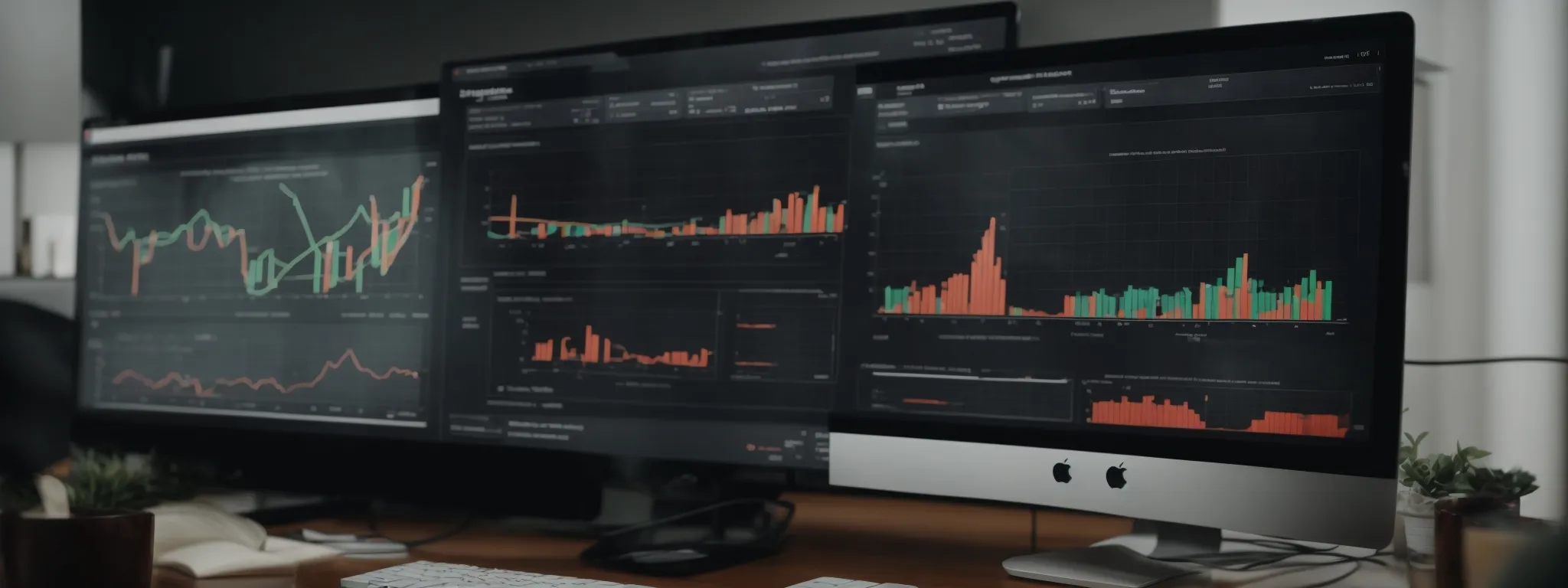Crafting Conversions: A Guide to Landing Page Tools
Maximizing Online Success: Crafting Conversions With Effective Landing Page Tools In the competitive realm of digital marketing, the efficacy of a landing page can make or break […]
Maximizing Online Success: Crafting Conversions With Effective Landing Page Tools
In the competitive realm of digital marketing, the efficacy of a landing page can make or break the success of an online campaign.
A meticulously crafted landing page resonates with the target audience, enhances user experience, and ultimately escalates conversion rates.
To achieve this pinnacle of online performance, selecting the right landing page tools is vital.
These tools empower marketers to build seamless, enticing pages that captivate potential customers and guide them through each step of the conversion funnel.
Keep reading to uncover the key features of landing page software that can truly transform clicks into customers.
Key Takeaways
- Properly Chosen Landing Page Tools Contribute to Conversion-Centric Design and Data-Driven Strategies
- A/B Testing Provides Empirical Data to Determine Which Elements of a Landing Page Lead to Higher Conversions
- Landing Page Tools Should Integrate Smoothly With Broader Marketing Technologies for a Cohesive Customer Journey
- Mobile Responsiveness and Dynamic Text Replacement Are Crucial for Engaging Users and Improving Conversion Rates
- Automation Tools in Landing Page Builders Streamline the Creation Process and Integrate With CRM for Effective Lead Management
Selecting Landing Page Tools Geared Toward Conversion

In today’s digital marketplace, the efficacy of a landing page can pivot on the fulcrum of conversion-centric design and analysis.
Craftsmen of the web understand that their tools must be chosen with care, ensuring alignment with specific conversion objectives.
A well-selected arsenal of landing page utilities provides more than just aesthetic appeal; it opens the door to data-driven strategies like A/B testing, which shed light on user preferences and behaviors.
Moreover, tools that seamlessly integrate with existing marketing technologies weave a cohesive narrative across various platforms, emboldening marketers to construct a symphony of touchpoints that resonate with their target audience.
Identify Your Conversion Goals Before Choosing Tools
Before the selection of tools to enhance a landing page begins, clarity on conversion goals is imperative. Determining what action or behavior qualifies as a successful conversion shapes the tactical approach in tool integration, throwing the spotlight on capabilities such as lead generation, sales, or newsletter sign-ups.
Entrepreneurs and marketers must weigh each tool against their predefined conversion objectives. This analytical approach ensures that the chosen utilities not only fortify the aesthetic layout but also underpin the strategic endeavors aimed at increasing the conversion rate effectively.
Understand the Importance of a/B Testing Features
A pivotal element in the optimization of landing pages is the application of A/B testing. This feature offers a pragmatic glimpse into various user interactions, illuminating which page elements are most Effective at Propelling Visitors toward the desired action.
Employing A/B testing allows marketers to make informed decisions backed by empirical data rather than intuition. By comparing different iterations of a landing page, crucial insights can be harnessed, bringing to light the path to improved conversion rates.
| Landing Page Version | Conversion Rate | User Engagement Metrics | Bounce Rate |
|---|---|---|---|
| Version A | 2.5% | Time on Page: 3 min | 40% |
| Version B | 4.0% | Time on Page: 4 min | 35% |
Look for Integrations That Complement Your Marketing Stack
As businesses curate their digital toolkit, the importance of landing page tools that integrate with an organization’s broader marketing stack cannot be understated. An ideally-equipped landing page tool provides compatibility with CRMs, email marketing platforms, and analytics services, creating a seamless flow of data and enabling a more comprehensive understanding of customer journeys.
Integrated systems facilitate a more holistic approach to marketing, with landing page performance metrics enriching the overall marketing intelligence. This connectivity aids in painting a fuller picture of campaign effectiveness, informing strategies that resonate with users and Nudging Them Closer to Making a Conversion.
Essential Features of High-Converting Landing Page Software

The digital landscape is a maelstrom of competition, where the articulation of brand messaging through landing pages can mark the difference between a passive visitor and a converted customer.
To this end, high-converting landing page software stands as a cornerstone for digital success, offering a suite of features that empower marketers to deploy effective strategies swiftly.
As businesses embark on this endeavor, it is essential to appraise the user-friendliness of drag-and-drop design interfaces, the efficacy of ready-to-use templates, and the indispensability of mobile responsiveness.
These features constitute the bedrock upon which agile, visually compelling, and universally accessible landing experiences are built, ensuring that conversions are not just an aspiration but a tangible outcome of well-executed design and functionality.
Explore Drag-and-Drop Functionality for Easy Design
In the realm of landing page creation, the drag-and-drop functionality represents an evolution in design autonomy and expediency. This feature enables marketers, irrespective of their technical expertise, to architect and customize pages swiftly, bringing to life Engaging Layouts that are conducive to higher conversion rates.
Leveraging this advanced user interface mechanism, landing page tools diminish the complexity traditionally associated with design and layout adjustments. The simplicity and intuitiveness of drag-and-drop afford users the agility to adapt to market trends and user feedback, optimizing landing pages in an ongoing process to maximize conversion potential.
Assess the Quality of Templates for Rapid Deployment
In the fast-paced arena of digital marketing, the utilization of high-quality templates is paramount for the quick deployment of landing pages. Seasoned professionals recognize that templates act as a foundational framework, ensuring pages not only maintain visual consistency with the brand but also cater to user expectations for coherence and easier navigation.
Companies must discern the adaptability of these templates, assessing whether they are robust and versatile enough to accommodate various content types and conversion strategies. A template’s true merit lies in its ability to be Customized Effortlessly, allowing it to resonate with specific campaign needs while expediting the launch process for businesses aiming to capitalize on emergent market opportunities.
Check for Mobile-Responsiveness Across Devices
With the proliferation of smartphones and tablets, mobile-responsiveness has surged to the forefront as a critical factor in landing page effectiveness. It is no longer a luxury but a necessity to ensure that a landing page adapts with grace to the screens of all sizes, delivering an optimal viewing experience that nurtures user engagement and fosters conversions.
Adept at accommodating the varied screen real estate, high-caliber landing page software automatically fine-tunes content, layout, and navigation to the specification of each mobile device. This responsiveness not only amplifies the user’s ease of interaction but also signals to search engines a commitment to usability, potentially bolstering the page’s rank in search results.
Increasing Conversion Rates With Landing Page Analytics

Amidst an ever-expanding online marketplace, leveraging analytics to decipher the performance of landing pages stands as a pivotal strategy to amplify conversion rates.
By interpreting key metrics rendered by specialized landing page tools, businesses can navigate the data landscape to make astute, data-driven decisions.
Companies can reshape page elements based on actionable insights and establish robust conversion tracking mechanisms to meticulously measure the efficacy of their efforts.
This data-guided approach not only optimizes user pathways to conversion but also transmutes casual browsing into definitive action.
Interpret Key Metrics Provided by Landing Page Tools
In the digital terrain where every click can lead to a conversion, the acuity to interpret key metrics provided by landing page tools is critical. These metrics act as a beacon, guiding marketers through the fog of user behavior insights to shore up strategies with a quantifiable impact on conversions.
Understanding the narrative these numbers unveil permits businesses to refine user experience and amplify the conversion potential. Metrics like engagement duration, bounce rate, and click-through rates lay the groundwork for iterative enhancements to landing page elements:
- Engagement duration helps gauge the content’s ability to captivate the audience.
- Bounce rate signals the relevance and initial impact of the landing page upon visitor arrival.
- Click-through rates provide a direct measure of the effectiveness of call-to-action prompts.
Make Data-Driven Decisions to Tweak Page Elements
In the pursuit of online prominence, savvy marketers equip themselves with landing page analytics to inform structural and content enhancements. Grounded in empirical evidence, each modification is meticulously calculated to nurture visitor engagement and guide them towards the desired conversion action.
The confluence of analytics and creativity catalyzes a realm of optimization for landing pages. Marketers adept in data interpretation agilely adjust elements strewn across the web canvas, bolstering the symphony of visuals, text, and user paths that culminate in conversion:
- Typography adjustments intensify readability, enhancing message delivery.
- Color scheme variations can evoke emotional responses, subtly swaying user decisions.
- Button placement optimization can lead to improved click-through rates.
With each implemented change predicated on analytics, businesses edify their landing pages not on conjecture, but on actionable insights that drive user interaction. It is this strategic approach that transforms potential into performance, setting the stage for increased conversion rates.
Set Up Conversion Tracking to Measure Success
Establishing robust conversion tracking is a pivotal step for businesses aspiring to gauge the true impact of their landing page efforts. This essential practice involves setting up specific metrics to capture when a visitor takes the defined action, whether it’s a purchase, a sign-up, or another conversion goal, empowering marketers to accurately assess the fruitfulness of their landing pages.
Utilizing conversion tracking, companies gain the capacity to distill their results into tangible data, presenting an unequivocal picture of success. By tracking conversions, they refine future marketing strategies with precision, ensuring resources are devoted to tactics that demonstrably drive results and contribute to the organization’s overall digital marketing success.
Tailoring User Experience With Custom Landing Page Elements

In the quest to elevate online performance, the customization of user experience on landing pages emerges as a vital component in the tapestry of digital strategy.
Attention to detail in crafting landing pages not only serves to captivate an audience but also, when fine-tuned to individual visitor segments, can significantly bolster conversion rates.
Employing dynamic text replacement and potent call-to-action buttons transforms a static page into a dynamic conversation with visitors, optimizing relevance and encouraging the fulfillment of strategic click-through objectives.
This pivotal section delves into the nuances of refining the user experience through personalized content, adaptive text, and compelling prompts that collectively converge to ultimately drive conversions.
Personalize Content to Visitor Segments for Better Results
Engaging diverse visitor segments with personalized content stands as a transformative strategy in enhancing user experience and conversion rates on landing pages. By tailoring messages to align with the nuances of different audience groups, LinkGraph’s SearchAtlas software empowers marketers to convey relevant value propositions, fostering a deeper connection and incentivizing desired actions.
LinkGraph’s SEO services extend the customization to atomic levels, where dynamic content based on user behavior, origin, or device type ensures that every interaction feels intuitively designed for individual needs. This approach, pioneered by the robust algorithms within SearchAtlas, allows brands to orchestrate unique user journeys that significantly outperform one-size-fits-all page designs in driving conversions.
Utilize Dynamic Text Replacement for Relevance
Dynamic text replacement stands at the vanguard of customization tools, enabling landing pages to adapt their messaging in real-time based on user search terms, location, or past user interaction. SearchAtlas, the esteemed platform from LinkGraph, ingeniously leverages this technology to ensure each visitor feels a personal connection to the content, thereby heightening the relevance and resonance of marketing campaigns.
Integrating this cutting-edge functionality, SearchAtlas enables businesses to craft a user-centric narrative that dynamically morphs to match the individuality of each visitor. By implementing such bespoke strategies, the software ensures engagement escalates, instinctively nurturing the visitor’s journey towards conversion with finesse and precision.
Implement Strong Call-to-Action Buttons for Better Click-Through
The potency of call-to-action (CTA) buttons as vehicles driving click-through rates holds undeniable influence in landing page optimization. When SearchAtlas SEO platform is employed, its utilization of advanced SEO software solutions enables the creation of compelling, action-oriented buttons that stand out gracefully, inviting users to take the next step in their customer journey.
Incorporating strategic design elements such as contrasting colors and persuasive language, CTAs crafted via the SEO Content Assistant can lead to a significant uplift in engagement and conversions. SearchAtlas’s user experience enhancements ensure that every CTA is positioned optimally, harmonizing with the surrounding content to create a natural progression for users, thus encouraging interaction and advancing marketing objectives.
Speeding Up Landing Page Creation With Automation Tools

In the digital age, the creation and maintenance of landing pages demand both precision and efficiency.
As businesses seek to optimize their online presence, the utilization of automation tools emerges as a pivotal means to streamline the development process of high-converting landing pages.
Integrating pre-set workflows not only conserves time and resources but also enhances consistency and quality.
Additionally, the symbiosis of landing pages with customer relationship management (CRM) systems automates lead capture, fortifying the data-driven approach to customer acquisition.
Maintaining the vitality of the landing page necessitates regular updates, a task that scheduled content deployment can manage autonomously.
Thus, these technological advancements empower the elevation of landing page strategy, sharpening its ability to serve as a formidable instrument in the digital marketer’s toolkit.
Use Pre-Set Workflows to Save Time and Resources
In the arena of digital marketing, the adoption of pre-set workflows represents a significant leap forward in streamlining the process of landing page creation. These automated sequences slash the time typically dedicated to repetitive tasks, enabling marketers to focus on more strategic initiatives that elevate the overall impact of their digital presence.
Leveraging automation tools, SearchAtlas by LinkGraph equips users with pre-configured sequences that expedite complex tasks like campaign tracking, split testing setup, and content distribution. This approach not only allocates scarce resources more judiciously but also ensures a consistent quality standard across all landing pages:
| Task | Manual Timing | Automated Workflow Duration |
|---|---|---|
| Campaign Setup | 6 hours | 1 hour |
| Content Distribution | 3 hours | 30 minutes |
| Split Testing | 4 hours | 1 hour |
Automate Lead Capture With CRM Integration
In the current digital ecosystem, automating lead capture with CRM integration is an indispensable feature for marketers striving to optimize their sales funnels. By funneling lead data directly from landing pages into customer relation management systems, companies ensure no prospect falls through the cracks, guaranteeing prompt follow-up actions and nurturing strategies.
LinkGraph’s SearchAtlas SEO platform excels in this domain, offering seamless CRM integrations that not only save precious time but also enrich the lead’s data profile for more personalized marketing efforts. This automation connects the initial user engagement on the landing page with a tailored journey through the sales pipeline, enhancing the likelihood of conversion:
| User Interaction | Data Capture | Integration with CRM | Follow-up Action |
|---|---|---|---|
| Form Submission | Contact Details | Automatic Entry | Email Sequence Initiation |
| CTA Click | Interaction Type | Profile Tagging | Targeted Content Delivery |
Schedule Content Updates to Keep Landing Pages Fresh
Ensuring that landing pages remain dynamic and topical is vital for sustained engagement and conversion rates. The implementation of scheduled content updates is a keystone in this process, allowing for the automatic refreshment of landing page elements to maintain relevance with current trends, seasonal offers, or marketing campaigns.
With SearchAtlas by LinkGraph, marketers can effortlessly program these updates, staging the deployment of content revisions without the need for manual intervention. This not only guarantees that landing pages reflect the most recent messaging but also streamlines the content management process, maintaining the freshness that is critical for captivating user interest and driving conversions.
Evaluating the Best Landing Page Builders for E-Commerce

For online retailers, the quest to distinguish their brand in the vast e-commerce landscape is underpinned by the choice of landing page builder used to convert traffic into sales.
Frontline digital storefronts require elevated functionality, honed for the high stakes of e-commerce performance metrics.
Businesses must find builders that deftly negotiate the intricacies of pricing and feature sets while seamlessly incorporating critical e-commerce components like payment gateways.
Insightful perspectives gleaned from real-world applications, as echoed in user testimonials, further elucidate the efficacy of these platforms.
The journey of assessment for the optimal landing page builder is both nuanced and instrumental in sculpting the foundation of a flourishing online commercial presence.
Compare Pricing and Features That Suit Online Retailers
For online retailers, selecting a landing page builder is a critical decision that impacts overall conversion rates and sales performance. It involves a balancing act between cost considerations and a comprehensive feature set that caters specifically to e-commerce needs, such as shopping cart integration and secure payment processing.
Features such as customizable templates, user-friendly design interfaces, and advanced analytics are essential for retailers to adapt quickly to market trends and consumer behavior. Scrutinizing these features alongside pricing structures allows businesses to invest in a landing page builder that offers the right blend of functionality and affordability:
| Builder | Key Features | Starting Price | e-Commerce Specific Functions |
|---|---|---|---|
| Builder A | Drag-and-Drop Editor, SEO Tools | $19/month | Payment Gateway Integration |
| Builder B | Responsive Templates, A/B Testing | $29/month | Shopping Cart, Coupon System |
Examine E-Commerce Specific Integrations Like Payment Gateways
For e-commerce entities, payment gateway integrations serve as a nexus between customer convenience and secure transactions. These integrations must be meticulously evaluated to ensure they not only provide a seamless checkout experience but also uphold stringent security protocols, safeguarding both the business and the consumer.
When assessing landing page builders, the caliber of payment gateways within their ecosystem emerges as a decisive factor:
- Does the platform support a diverse range of payment methods, from credit cards to digital wallets?
- Are transaction fees reasonable without compromising on transaction speed and reliability?
- Is the payment process customizable to maintain brand consistency throughout the shopping experience?
Review User Testimonials for Real-World Effectiveness
User testimonials offer a pragmatic lens through which the effectiveness of landing page builders for e-commerce can be gauged. These real-world accounts provide tangible evidence of a platform’s capacity to drive conversions, showcasing the successes and challenges faced by online retailers in diverse market sectors.
Analyzing these firsthand experiences assists in discerning the overall user satisfaction and the platform’s impact on sales metrics. The weight of authentic user feedback acts as a reliable barometer for prospective users, helping to navigate the decision-making process with confidence and clarity.
Conclusion
In the competitive realm of online marketing, the key to maximizing success lies in crafting landing pages optimized for conversions.
Achieving this requires a meticulous selection of tools that align with conversion goals, whether it’s generating leads, closing sales, or encouraging newsletter sign-ups.
A well-chosen suite of landing page tools empowers marketers to conduct A/B testing, yielding insights into user behaviors and allowing for data-driven adjustments that enhance conversion rates.
Integration with the wider marketing stack is essential, ensuring a seamless data flow and comprehensive customer journey analysis.
Moreover, high-converting landing page software should include user-friendly design features, such as drag-and-drop functionality, high-quality templates, and mobile responsiveness to ensure an engaging and universally accessible user experience.
Furthermore, leveraging landing page analytics is pivotal to understanding key performance metrics, informing strategic page element tweaks, and setting up conversion tracking to measure the success of these efforts.
Personalized content and dynamic elements, such as text replacement and persuasive call-to-action buttons, tailor the user experience to different segments, significantly increasing the likelihood of conversion.
Utilizing automation tools accelerates the creation and maintenance of landing pages, streamlining processes like content updates and lead capture with CRM integration.
For e-commerce specifically, evaluating landing page builders against necessary features, pricing, and payment gateway integrations is crucial, with real-world user testimonials offering valuable insights into their effectiveness.
In conclusion, for businesses to thrive online, they must adeptly employ effective landing page tools designed to craft a compelling user journey that converts browsers into loyal customers.















































































